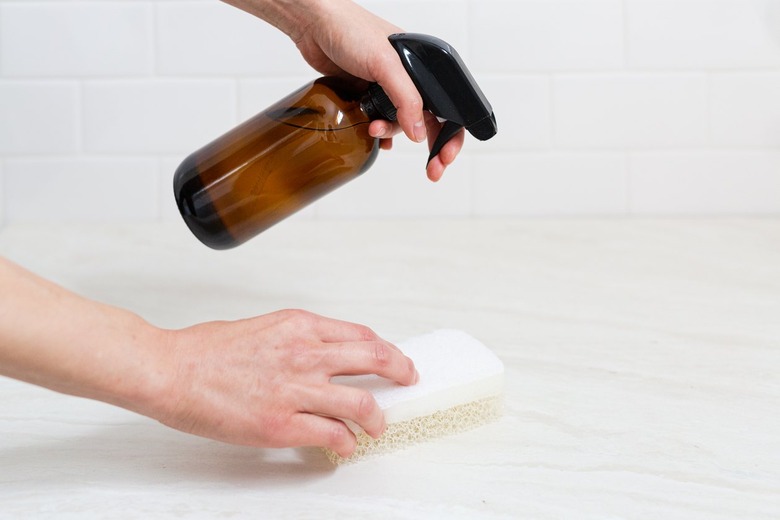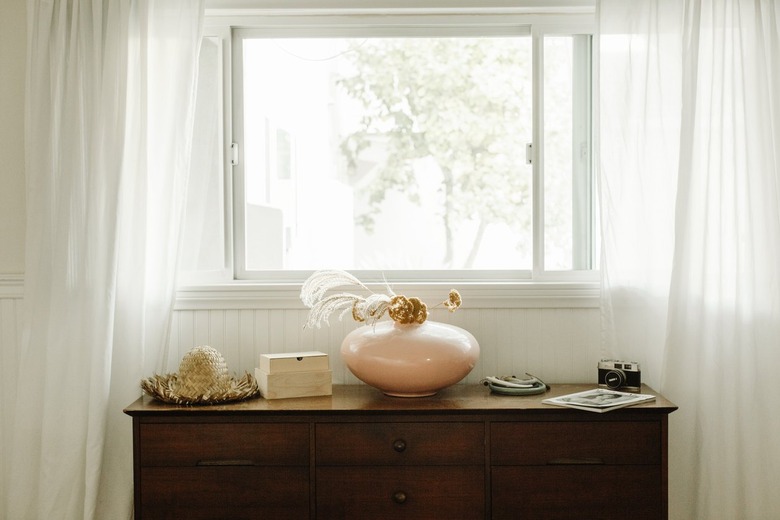14 Ways To Improve Your Indoor Air Quality
We may receive a commission on purchases made from links.
Americans spend an average of 90 percent of their time indoors, according to the Environmental Protection Agency (EPA), and those who are most affected by pollution, such as the elderly, children and those with respiratory conditions, tend to spend even more time inside — making it crucial to keep the air inside your home healthy and safe. Unfortunately, indoor air quality is generally very poor compared to the air outdoors since pollutants tend to get trapped inside and are recycled through your heating, ventilation and air conditioning (HVAC) system, particularly during chilly winters when the windows tend to remain sealed for months at a time. However, there are some simple things you can do to improve the air quality inside your home year-round.
1. Keep Your House Clean
1. Keep Your House Clean
The best way to get rid of allergens, such as dust mites and pet dander, is to keep your house clean. The more you let these contaminants accumulate in your home, the worse your indoor air quality will be. Start by using a microfiber dusting cloth to wipe down surfaces like shelves, blinds, fan blades and the top of your furniture and even wipe your walls on occasion. Do not use a traditional feather duster or a similar duster that simply moves dust into the air because this further reduces the quality of the air in your home. Instead, use a microfiber cloth to trap the dust. These cloths can be easily cleaned after use by shaking the dust loose outside and then throwing them in a washing machine.
Dusting helps remove dust and other allergens higher up in your home, but the majority of dirt particles and pet dander gets trapped in carpets and rugs on the floor, so it's best to vacuum once or twice a week to eliminate these issues. Only use a vacuum cleaner with a high-efficiency particulate air filter, as these filters trap the most allergens. As an alternative, consider replacing your carpet with hard-surface flooring in every room since it can be swept free of allergens much more easily and efficiently. Whatever your flooring type, to avoid tracking in pollutants and to keep your floors cleaner, leave your shoes outside.
Regularly wash your bed sheets, drapes, pet bedding, upholstery and other materials that can hold indoor air pollutants. Wash these materials in water that is at least 130 degrees Fahrenheit to kill off dust mites and consider putting covers on your mattress, box spring and pillows. You may also consider investing in IKEA's new air purifying curtains that trap volatile organic compounds (VOCs) and break them down into nontoxic substances when exposed to sunlight.
2. Take Good Care of Your Pets
2. Take Good Care of Your Pets
Even if you don't have pet allergies, taking proper care of your pet can help reduce allergens in your home. Brush and groom your dog or cat regularly, taking special care to trim the hair on your pooch's feet and behind so he tracks in less mess after walking or sitting outside. Be sure to regularly clean your cat's litter box, scoop up your dog's waste in the backyard and make sure your fish tank doesn't get too dirty.
3. Choose Cleaning Products Carefully
3. Choose Cleaning Products Carefully
Try to avoid cleaning products with toxic fumes, such as ammonia or bleach, but keep in mind that sometimes, these are the preferred options for specific situations. For example, if you're trying to clean mold, bleach is often the best choice to kill all the mold spores. When you use strong cleansers like these, use a mask and air out your house as much as possible by opening your windows and using exhaust fans until the fumes have all escaped.
4. Declutter Your Home
4. Declutter Your Home
You don't need to live life as a minimalist, but if you're trying to improve the air quality in your home, it can help to eliminate unnecessary clutter, especially on countertops, tables and shelves, where dust tends to accumulate. Marie Kondo's methods help some people feel that they're truly living their best life, but even if the best you can do is to shove clutter into closets and cupboards, it can still improve your overall air quality by reducing dust buildup.
5. Turn to Natural Pest Killers
5. Turn to Natural Pest Killers
When you have roaches, ants, fleas or other bugs in your home, you may be tempted to turn to aerosol sprays or foggers to eliminate the pests, but these pesticides aren't exactly good for your health. While these are occasionally your last-resort option, it's a good idea to start with natural products first. Essential oils, glue-based traps, neem oil and diatomaceous earth are all good options depending on the situation, but before taking action, do a little research on the right solution for the specific pest.
Rather than waiting to treat a pest infestation after it starts, take measures to prevent infestations. Seal all small holes where rodents may enter your home, check that your window screens are all hole-free and make sure to keep your doors securely shut. Keep trash in a secured trash can away from your home and store food in airtight containers to avoid attracting pests. Trim plants and trees so they don't touch your house, as they can provide critters with easy entry to your home. Keep your grass and other plants trimmed so they don't provide good hiding places for small creatures.
If you do need to use toxic commercial pesticides, always do so according to manufacturer directions and ventilate your home as much as possible after treatments.
6. Don't Rely on Plants
6. Don't Rely on Plants
Although studies have shown that some houseplants can improve indoor air quality by removing dangerous VOCs, these studies are based on laboratory tests where the plants were kept in an airtight container only 2 feet wide and 2 feet long that was pumped full of toxic chemicals. In real-world conditions, plants simply can't compete with the effectiveness of a good air purifier or even an open window. Even worse, your beloved houseplant's leaves can become a dust trap, and if the soil is kept too wet, it can harbor algae, mold spores or mildew. In other words, an indoor plant will at best do nothing substantial and at worst, it can cause additional air quality problems.
7. Avoid Scented Products
7. Avoid Scented Products
Candles, scented cleaning products and air fresheners can all make your home smell nicer, but they often contain dozens of VOCs. These emissions can cause headaches and irritation to your eyes, throat and nose in the short term and more serious problems, like cancer or central nervous system disorders, in the long run. Instead, opt for natural scents you can get from plants, like citrus fruits and herbs.
8. Keep Your HVAC System Maintained
8. Keep Your HVAC System Maintained
Your HVAC system can help cycle air through your home, and your air conditioner can even reduce your humidity level, so with tasks this important, it's a good idea to keep these systems maintained regularly. Clean air filters can help filter out airborne pollutants so they aren't recirculated through your whole home whenever you run the heater or air conditioning. For best results, change your filter every 12 months.
It may be tempting to clean your air ducts to reduce potential allergens in your HVAC system, but duct cleaning has not actually been shown to reduce health problems nor have studies indicated that particulate levels are higher in homes with dirty air ducts. There's not really a major downside to having your air ducts cleaned other than the expense, but you certainly don't want to spend hundreds of dollars on duct cleaning to have it do nothing for your air quality. In fact, you should only clean your ducts if they have visible mold growth, are infested with vermin or are clogged with excessive dust or debris. Even then, you should get your ducts cleaned only after you address the underlying issues.
9. Buy Some Good Air Purifiers
9. Buy Some Good Air Purifiers
If these techniques don't help, air purifiers are a great option to further reduce your indoor air pollution. Simply place one in each of the most commonly used areas of your home (your living room, bedrooms, kitchen, etc.) and leave them on as much as possible, even when you're not in the room. The filtration system of these devices captures many of the irritants that can cause allergies, though it's worth mentioning that nothing can remove all allergens completely.
10. Use a Dehumidifier
10. Use a Dehumidifier
If your home has moisture-related issues, such as mold or mildew, a dehumidifier can make a world of difference. Buy a device that is sized according to your needs and place it where you have the greatest issues with moisture, like a basement or a bathroom with no exhaust fan or window.
For spaces where a dehumidifier is too cumbersome, moisture absorbers can pull moisture from the air without any electricity. Once you've installed the dehumidifier or have started using a moisture remover, be sure to scrub the walls and other surfaces to remove any mold that has already accumulated. Continue to ventilate the area as much as possible and remember to empty the dehumidifier tank or replace the moisture remover as often as is necessary.
For best results, keep the relative humidity at a level between 40 and 50 percent, which is the sweet spot providing the most hospitable range for humans and a less hospitable range for mold, bacteria and viruses.
11. Use Your Fan When Cooking
11. Use Your Fan When Cooking
When cooking, always use your exhaust fan to help get smoke and other fumes out of your home. This is also a great way to ensure you won't end up smelling tonight's salmon tomorrow morning. Don't forget to change the filter above your range regularly since they can quickly get clogged with smoke and oil residue.
12. Use Indoor Air Quality Monitors
12. Use Indoor Air Quality Monitors
A lot of people assume that they'll be able to tell if their home's air quality is poor based on the smell, but while you may be able to smell some fumes and gases, carbon monoxide, carbon dioxide and radon are all odorless. That means you can have dangerous levels of these toxic gases without knowing it.
That's why it's a good idea to install an indoor air quality (IAQ) meter. While these devices can't test for every possible danger, you can find monitors that can test for a number of potential hazards, including gases, particulate matter (including asbestos and other dangerous particles that can cause lung cancer) and even excessive humidity. For example, the Airthings Wave Plus monitors your home for humidity, radon, VOCs and carbon dioxide, while the Awair Element tests for humidity, atmospheric particulate matter, carbon dioxide and VOCs.
When these devices detect poor air quality, they'll turn on an indicator light, and many can also send texts to your mobile device. Some may even be integrated with your other smart devices and can turn on dehumidifiers, air purifiers or fans to help make the air cleaner when the quality drops.
13. Open the Windows
13. Open the Windows
If you've ever noticed that your indoor air quality is worse during the winter compared to the summer, then you have some idea of how important it is to improve air exchange in your home. Even in the winter months, it can be beneficial to open your windows and let in fresh air if you can stand letting your home become a little chillier for a few hours. In fact, the stale, musty air being recirculated through a home in winter can cause serious health problems for those with respiratory issues or sensitivities to indoor allergens.
14. Install an Air Exchanger
14. Install an Air Exchanger
When it's too cold to open your windows in the winter or too hot to do so in the summer, you may instead consider getting an air exchanger (these are standard in many new homes), which brings in fresh air from outside and sends it through a filter so you have clean, fresh air entering your home. These devices are also good options for those who are wary of letting in outdoor air during high pollen-count days in spring or summer.
References
- United States Environmental Protection Agency: Indoor Air Quality
- AARP: How to Improve Your Indoor Air Quality
- Blue Ox Heating & Air: Why You Should Have an Air Exchanger
- Tech Hive: The Best Indoor Air Quality Monitors: Identify the Pollutants That Can Compromise Your Health and Comfort
- Harvard Health Publishing: Easy Ways You Can Improve Indoor Air Quality
- National Geographic: Which Houseplants Should You Buy to Purify Air? None of Them.
- United States Environmental Protection Agency: Should You Have the Air Ducts in Your Home Cleaned?




